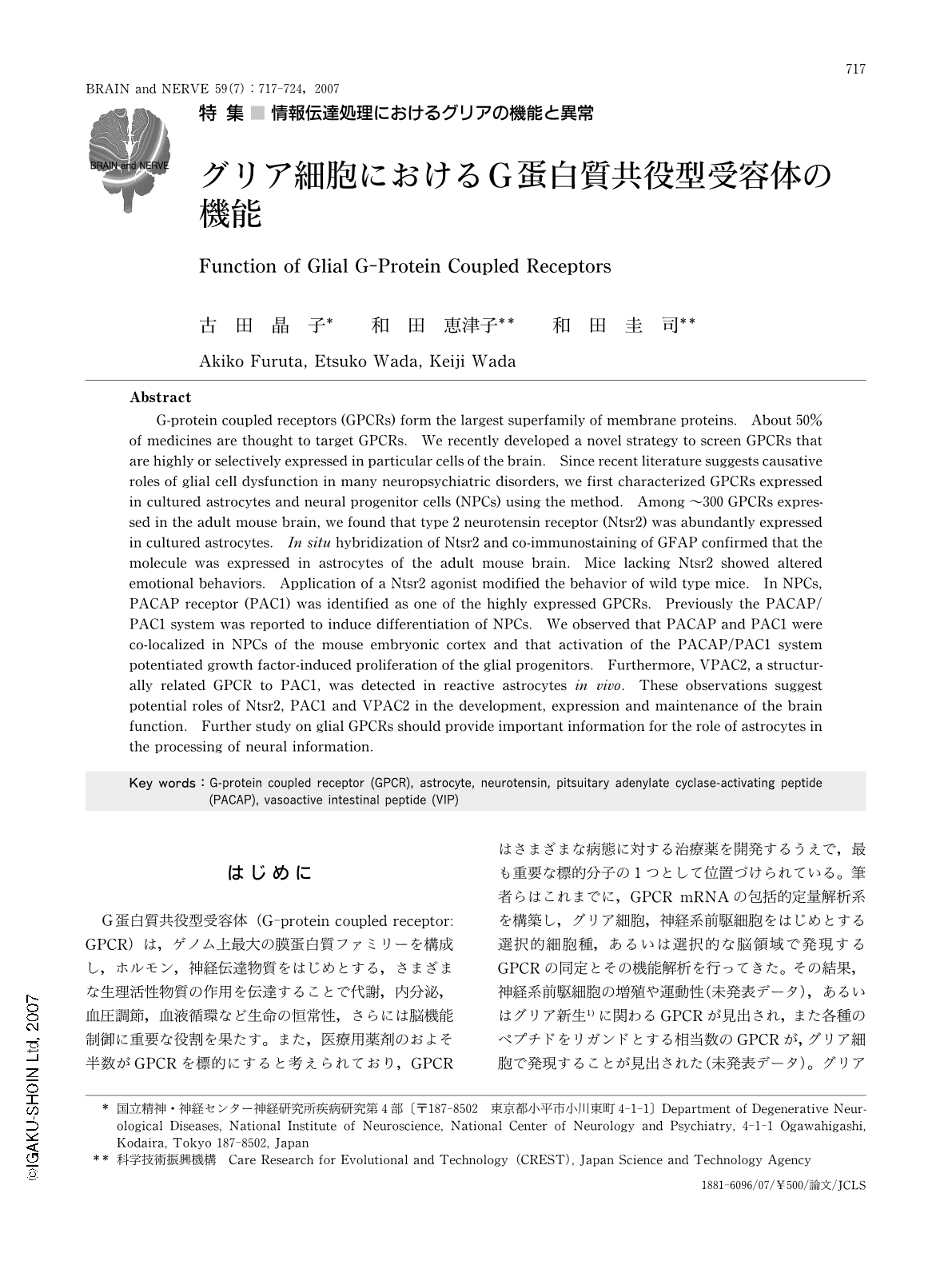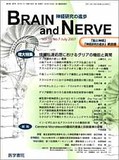Japanese
English
- 有料閲覧
- Abstract 文献概要
- 1ページ目 Look Inside
- 参考文献 Reference
はじめに
G蛋白質共役型受容体(G-protein coupled receptor:GPCR)は,ゲノム上最大の膜蛋白質ファミリーを構成し,ホルモン,神経伝達物質をはじめとする,さまざまな生理活性物質の作用を伝達することで代謝,内分泌,血圧調節,血液循環など生命の恒常性,さらには脳機能制御に重要な役割を果たす。また,医療用薬剤のおよそ半数がGPCRを標的にすると考えられており,GPCRはさまざまな病態に対する治療薬を開発するうえで,最も重要な標的分子の1つとして位置づけられている。筆者らはこれまでに,GPCR mRNAの包括的定量解析系を構築し,グリア細胞,神経系前駆細胞をはじめとする選択的細胞種,あるいは選択的な脳領域で発現するGPCRの同定とその機能解析を行ってきた。その結果,神経系前駆細胞の増殖や運動性(未発表データ),あるいはグリア新生1)に関わるGPCRが見出され,また各種のペプチドをリガンドとする相当数のGPCRが,グリア細胞で発現することが見出された(未発表データ)。グリア細胞はこれまで単なる神経細胞の支持細胞として位置づけられることが多かったが,近年の研究から,ニューロン・グリア相互作用を通して神経伝達の制御に積極的に関わっていることが明らかとなってきている2)。またグリア細胞のなかでも特にアストロサイトは血管内皮細胞,ペリサイトとともに血脳液関門を構成しており,末梢組織からの生体情報の検出,あるいは脳内への物質の取り込み・排出などに関しても重要な役割を果たすと考えられている。グリア細胞に存在するGPCRはこれらニューロン・グリア相互作用,さらには脳内代謝制御を実行する分子として重要であると筆者らは考えており,その機能解析を通して神経伝達制御だけでなく内分泌代謝,免疫など脳が受容するさまざまな生体情報の処理に関しても,新たな成果が生み出されると考えている。また,精神神経疾患の病態形成におけるグリアの役割解明,グリアを標的にした治療法の開発などについても,従来の概念を超えた新たな展開が期待できると考えている。本稿ではアストロサイトに発現するGPCRのうち,情動性記憶におけるニューロテンシン2型受容体の役割と,発生期のアストロサイト新生,および成体脳損傷時の反応性アストロサイトにおけるpitsuitary adenylate cyclase-activating peptide (PACAP)/vasoactive intestinal peptide (VIP)受容体の役割について,これまでの研究の進展を概説する。
Abstract
G-protein coupled receptors (GPCRs) form the largest superfamily of membrane proteins. About 50% of medicines are thought to target GPCRs. We recently developed a novel strategy to screen GPCRs that are highly or selectively expressed in particular cells of the brain. Since recent literature suggests causative roles of glial cell dysfunction in many neuropsychiatric disorders, we first characterized GPCRs expressed in cultured astrocytes and neural progenitor cells (NPCs) using the method. Among ~300 GPCRs expressed in the adult mouse brain, we found that type 2 neurotensin receptor (Ntsr2) was abundantly expressed in cultured astrocytes. In situ hybridization of Ntsr2 and co-immunostaining of GFAP confirmed that the molecule was expressed in astrocytes of the adult mouse brain. Mice lacking Ntsr2 showed altered emotional behaviors. Application of a Ntsr2 agonist modified the behavior of wild type mice. In NPCs, PACAP receptor (PAC1) was identified as one of the highly expressed GPCRs. Previously the PACAP/PAC1 system was reported to induce differentiation of NPCs. We observed that PACAP and PAC1 were co-localized in NPCs of the mouse embryonic cortex and that activation of the PACAP/PAC1 system potentiated growth factor-induced proliferation of the glial progenitors. Furthermore, VPAC2, a structurally related GPCR to PAC1, was detected in reactive astrocytes in vivo. These observations suggest potential roles of Ntsr2, PAC1 and VPAC2 in the development, expression and maintenance of the brain function. Further study on glial GPCRs should provide important information for the role of astrocytes in the processing of neural information.

Copyright © 2007, Igaku-Shoin Ltd. All rights reserved.


